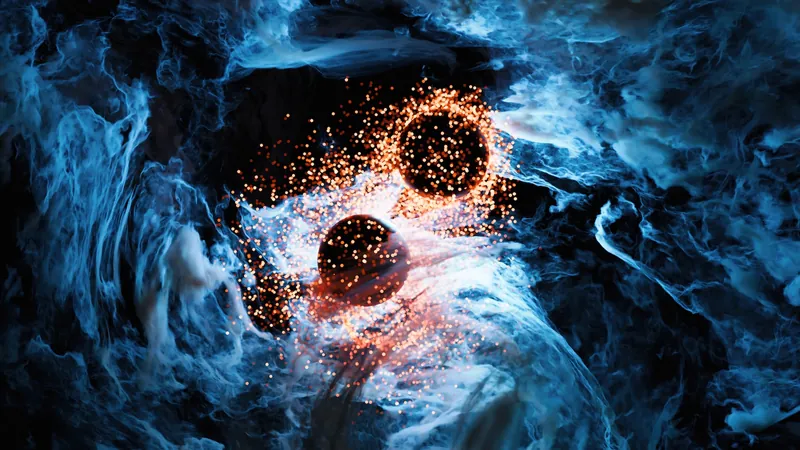
Are We Finally Close to a 'Theory of Everything'? Physicists Rethink Einstein's Gravity!
2025-05-15
Author: Noah
A Groundbreaking Approach to Uniting Gravity and Quantum Physics
In a monumental leap in theoretical physics, researchers have unlocked a new strategy aimed at bridging the long-standing gap between gravity and quantum mechanics. Their recent publication in the journal *Reports on Progress in Physics* details an innovative reformulation of gravity that could pave the way for a quantum-compatible understanding of the universe — all without resorting to the controversial notions of extra dimensions or the complex structures often seen in string theory.
Rethinking Gravity: A Radical Shift
At the core of this novel proposal lies a reimagining of gravity's fundamental properties. Unlike the strong, weak, and electromagnetic forces, which are elegantly explained through quantum field theory, gravity has stubbornly remained a classical phenomenon, dictated by Einstein's general relativity. This theory portrays gravity not as a force but as the curvature of space-time, driven by mass and energy. However, the quest to fuse this classical view with quantum mechanics has typically led to insurmountable mathematical inconsistencies.
Introducing Four Interrelated Fields
The scientists' new perspective suggests a model where gravity is conveyed through four interlinked fields, akin to those governing electromagnetism. Each field reacts to mass in a similar fashion to how electric and magnetic fields respond to electric charge and current. This intricate dance among the fields not only honors classical gravity but also seamlessly incorporates quantum dynamics.
Avoiding Historical Pitfalls
By mirroring the structure of established quantum theories, this approach sidesteps the mathematical quagmires that have traditionally obstructed the quantization of gravity. Researchers assert their framework introduces a coherent quantum theory, eliminating common issues like unbounded quantities and negative probabilities that often plague attempts to quantize general relativity using straightforward methods.
Simplicity is Key: No Extra Dimensions Required!
A standout characteristic of this theory is its simplicity. Unlike many quantum gravity models that necessitate the existence of unseen particles or additional forces, this proposal remains anchored in familiar concepts. As Jukka Tulkki, a professor and co-author, pointed out, their model avoids the need for extra dimensions that lack experimental validation.
Exciting Possibilities Ahead
While the model shows great promise, it’s still in its infancy. Preliminary calculations suggest that it passes conventional consistency checks, yet a comprehensive proof of its robustness is still pending. Furthermore, the framework needs to be evaluated against some of the most perplexing issues in gravity, including black hole singularities and the physics surrounding the Big Bang.
The Challenge of Experimental Verification
As for experimental validation, the challenge is formidable. Gravity, being the weakest of the four fundamental forces, presents unique difficulties in probing its quantum dimensions. Tulkki reminds us that testing quantum gravity effects is a tall order given gravity’s elusive nature. Nonetheless, the lack of adjustable parameters means any future experimental endeavors could yield findings that either support or invalidate this intriguing theory.
A New Dawn for Theoretical Physics?
The authors believe it may take decades to achieve the first experimental validations of quantum gravity, but indirect evidence could surface much sooner. For now, this fresh framework stands to guide theorists in their ongoing quest for a quantum theory of gravity, potentially unraveling some of the universe’s most profound mysteries! Stay tuned for what could be the next big leap in our understanding of reality!









 Brasil (PT)
Brasil (PT)
 Canada (EN)
Canada (EN)
 Chile (ES)
Chile (ES)
 Česko (CS)
Česko (CS)
 대한민국 (KO)
대한민국 (KO)
 España (ES)
España (ES)
 France (FR)
France (FR)
 Hong Kong (EN)
Hong Kong (EN)
 Italia (IT)
Italia (IT)
 日本 (JA)
日本 (JA)
 Magyarország (HU)
Magyarország (HU)
 Norge (NO)
Norge (NO)
 Polska (PL)
Polska (PL)
 Schweiz (DE)
Schweiz (DE)
 Singapore (EN)
Singapore (EN)
 Sverige (SV)
Sverige (SV)
 Suomi (FI)
Suomi (FI)
 Türkiye (TR)
Türkiye (TR)
 الإمارات العربية المتحدة (AR)
الإمارات العربية المتحدة (AR)